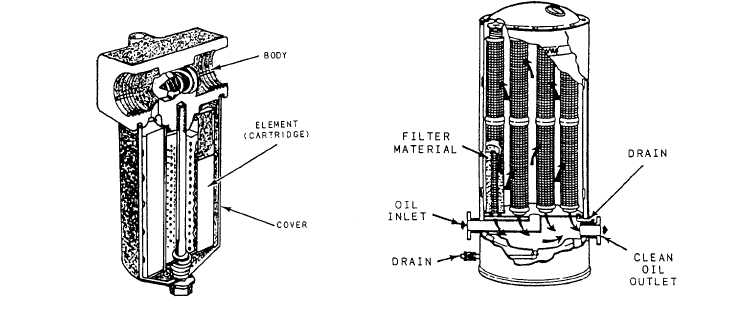filters. Such a filter might be used where system
components, such as valves, are less dirt-tolerant
than the pump. The filter thus would trap this fine
contamination from the fluid as it leaves the
pump. Pressure line filters must be able to with-
stand the operating pressure of the system.
Return Line Filters
Return line filters (fig. 9-43) also can trap very
small particles before the fluid returns to the
reservoir/tank. They are particularly useful in
systems that do not have large reservoirs/tanks
to allow contaminants to settle out of the fluid.
A return line filter is nearly a must in a system
with a high-performance pump, which has very
close clearances and usually cannot be sufficiently
protected by an inlet line filter.
FILTER/STRAINER MATERIALS
The materials used in filters and strainers are
classified as mechanical, absorbent, or adsorbent.
Most strainer material is of the mechanical type,
which operates by trapping particles between
closely woven metal screens and/or disks, and
metal baskets. The mechanical type of material
is used mostly where the particles removed from
the medium are of a relatively coarse nature.
Absorbent filters are used for most minute-
particle filtration in fluid systems. They are made
of a wide range of porous materials, including
paper, wood pulp, cotton, yarn, and cellulose.
Figure 9-44.—Filter assembly using a surface-type element.
Paper filters are usually resin-impregnated for
strength.
Adsorbent (or active) filters, such as charcoal
and fuller’s earth, are used mostly in gaseous or
vapors systems. This type of filter material should
not be used in hydraulic systems since they remove
essential additives from the hydraulic fluid.
CONSTRUCTION OF
FILTER ELEMENTS
Filter elements are constructed in various
ways. The three most common filter element
construction types are the surface type (most
common), the depth type, and the edge type.
Surface-type filter elements (fig. 9-44) are
made of closely woven fabric or treated paper with
pores to allow fluid to flow through. Very
accurate control of the pore size is a feature of
the surface-type elements.
A depth-type filter element (fig. 9-45) is
composed of layers of a fabric or fibers, which
provide many tortuous paths for the fluid to flow
through. The pores or passages vary in size, and
the degree of filtration depends on the flow rate.
Increases in flow rate tend to dislodge trapped
particles. This filter is limited to low-flow, low
pressure-drop conditions.
Figure 9-45.—Depth-type filter element.
9-29

